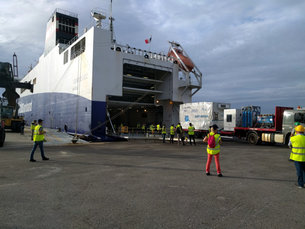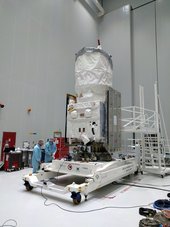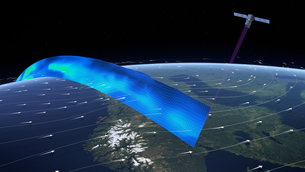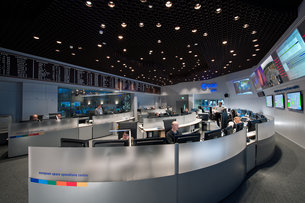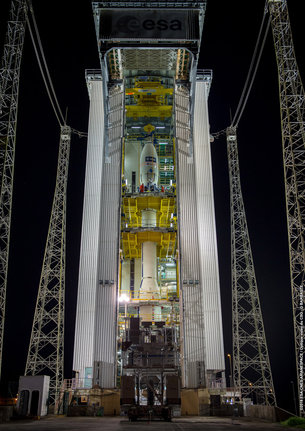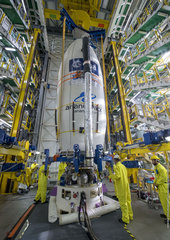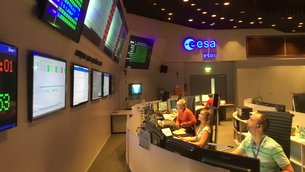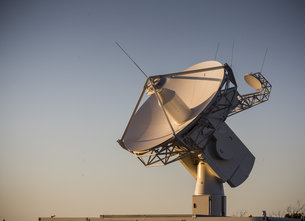7.07.2018
FULL STEAM AHEAD FOR AEOLUS LAUNCH
Having set sail from France on 15 June - Global Wind Day, ESA’s Aeolus wind satellite has arrived safe and sound at the launch site in French Guiana.
While almost all satellites travel by aircraft, Aeolus’ journey was rather different – it travelled all the way across the Atlantic from Saint Nazare, western France to the Port of Cayenne, French Guiana by ship.
Aeolus carries one of the most sophisticated instruments ever to be put into orbit. A 12-day journey was undertaken to avoid potential damage caused by air re-pressurisation during descent had the satellite travelled by air – a quicker but decidedly riskier option.
Upon its long-awaited arrival, the team unloaded Aeolus and its support equipment. The containers were then carefully positioned on a truck to be transported to the launch site about 60 km away, where the satellite container was moved into the airlock, to stabilise after its long journey.
The satellite was then removed from its container, placed on its integration trolley for testing and connected to its electrical support equipment. Initial checks indicate that Aeolus has withstood its journey from France in good condition.
ESA’s Aeolus project manager, Anders Elfving, said, “We are obviously all extremely pleased that Aeolus has now arrived at the launch site. An awful lot of work and planning went into making sure it arrived safe and sound – now it’s full steam ahead for preparing the satellite for liftoff on 21 August.”
A range of checks will be carried out on the satellite in the cleanroom before the scheduled liftoff on a Vega rocket on 21 August at 21:20 GMT (23:20 CEST) from Europe’s spaceport near Kourou.
This pioneering mission is set to provide global wind-profile data, using powerful laser technology that probes the lowermost 30 km of our atmosphere to yield vertical profiles of the wind and information on aerosols and clouds.
The mission will improve our understanding of how atmosphere dynamics work and contribute to climate change research. At the same time, it will also help to predict extreme events such as hurricanes and help us to better understand and model large-scale wind patterns driving weather such as El Niño.
It is also expected to bring considerable benefits to society by improving weather forecasts. Its global wind measurements, delivered almost in real time, are exactly what meteorological centres are looking for to improve their forecasts.
ESA’s Aeolus mission scientist, Anne Grete Straume, added, “We expect Aeolus to advance science, whilst at the same time having a range of potential practical application areas by improving forecasts, which is of importance to the wind energy industry, for example. Accurate forecasts are just one of the ways in which our mission will be able to help".
+++
AEOLUS UNVEILED AND SWITCHED ON
Following its arrival at Europe’s spaceport in Kourou, French Guiana, on 29 June, the Aeolus satellite has been taken out from its transport container, placed on its integration trolley for testing and connected to its electrical support equipment.


ESA’s Aeolus project manager, Anders Elfving, said, “We are obviously all extremely pleased that Aeolus has now arrived at the launch site. An awful lot of work and planning went into making sure it arrived safe and sound – now it’s full steam ahead for preparing the satellite for liftoff on 21 August.”
The team has also done the ‘ launch adapter fit check’, which is to make sure that the satellite actually fits the Vega rocket adapter and confirms that everything is aligned. This too went well.

Quelle: ESA
---
Update: 13.08.2018
.
PRESSEEINLADUNG: START DER WIND-MISSION AEOLUS AM 21. AUGUST
Die Aeolus-Mission, bei der eine revolutionäre Lasertechnologie zur Messung von Winden rund um die Erde zum Einsatz kommt, wird am 21. August von Europas Raumflughafen Kourou in Französisch-Guayana aus ins All aufbrechen. Medienvertreter sind eingeladen, den Start des jüngsten Erdforschungssatelliten im Europäischen Raumflugkontrollzentrum (ESOC) in Darmstadt mitzuverfolgen.
Diese bahnbrechende Mission nutzt eine leistungsstarke Lasertechnologie, mit der zur Erstellung vertikaler Windprofile und Sammlung von Informationen über Aerosole und Wolken die unteren 30 km unserer Atmosphäre abgetastet werden, was einen völlig neuen Ansatz zur Messung von Winden aus dem Weltraum darstellt.
Obwohl unsere täglichen Wettervorhersagen Informationen über den Wind umfassen, werden keine direkten Messungen durchgeführt. Wissenschaftler und Meteorologen benötigen zum besseren Verständnis der Systeme, die unser Wetter und Klima beeinflussen, und zur Verbesserung der Vorhersagen jedoch genaue und zeitnahe Winddaten. Aeolus ist der erste Satellit, der diese Informationen bereitstellen kann.
Der Start an Bord einer Vega-Rakete ist für den 21. August um 23.20 Uhr MESZ geplant.
Die neuesten Nachrichten und Informationen zu dieser Mission sind unter www.esa.int/aeolus zu finden.
Der Twitter-Hashtag ist #Aeolus.
Live-Programm zum Start von Aeolus im Europäischen Raumflugkontrollzentrum der ESA
Das Programm beginnt um 22.00 Uhr MESZ und umfasst kurze Informationsrunden zu den wissenschaftlichen Zielen dieser neuen Windmission, ihrem komplexen Laserinstrument und der Nutzung der gewonnenen Daten sowie Live-Updates der Teams im ESOC-Hauptkontrollraum und vom Startplatz in Kourou. Für Einzelinterviews werden Missionsspezialisten zur Verfügung stehen.
Programm (alle Zeitangaben in MESZ)
20.30 Uhr Einlass
21.15 Uhr Medienbesuch im ESOC-Kontrollzentrum
22.00 Uhr Beginn des Veranstaltungsprogramms im ESOC-Pressenzentrum:
Grußwort des Leiters des ESOC und Direktors für Missionsbetrieb, Rolf Densing, und des Leiters der ESA-Erdbeobachtungsprojekte, Philippe Goudy, mit anschließender Gesprächsrunde mit Missionsspezialisten und Meteorologieexperten.
22.50 Uhr Liveschaltung nach Kourou
23.20 Uhr Start von Aeolus (Live-Übertragung)
23.35 Uhr Pause
00.30 Uhr Erneute Liveschaltung nach Kourou
01.00 Uhr Ende des Programms
Anmeldung
Anmeldung bis Freitag, 17. August über folgendes Anmeldeformular:
https://se.myconvento.com/public/event_register/do_register/2367916
Veranstaltungsort
ESA–ESOC
Robert-Bosch-Straße 5
64293 Darmstadt
Quelle: ESA
---
Update: 15.08.2018
.
AEOLUS IN LAUNCH TOWER
ESA’s Aeolus wind satellite is poised for liftoff from Europe’s Spaceport in Kourou, French Guiana. This latest Earth Explorer satellite has been at the launch site since early July being readied for its ride into space on 21 August at 21:20 GMT (23:20 CEST).
Aeolus was sealed from view in its Vega rocket fairing last week, after which it was rolled out to the launch pad, hoisted into the launch tower and joined to the rest of the rocket.
Like all of ESA’s Earth Explorer missions, Aeolus will fill a gap in our knowledge of how our planet works and show how novel technology can be used to observe Earth from space.
Aeolus carries one of the most sophisticated instruments ever to be put into orbit.
The first of its kind, the Aladin instrument includes revolutionary laser technology to generate pulses of ultraviolet light that are beamed down into the atmosphere to profile the world’s winds – a completely new approach to measuring the wind from space.
This technology has been particularly challenging to develop and consequently it has taken some years to get this far.
ESA’s Director of Earth Observation Programmes, Josef Aschbacher, said, “Aeolus has certainly posed some technical challenges, but after all it is completely new – the wind has never been measured from space this way before.
“Aeolus is set to be a game changer for understanding the dynamics of our atmosphere and it will have real-world applications by being used to improve our weather forecasts.
“The development path may have been somewhat rocky, but we are all thrilled to see it now in the launch tower awaiting its big day.”
By profiling the lowermost 30 km of the atmosphere, Aeolus will give scientists global information on the speed of the wind in near-real time.
This will improve our understanding of how wind, pressure, temperature and humidity are interlinked.
This new mission will also provide insight into how the wind influences the exchange of heat and moisture between Earth’s surface and the atmosphere. These aspects are important for understanding climate change.
As well as advancing science and improving weather forecasts, data from Aeolus will be used in air-quality models to improve forecasts of dust and other airborne particles that affect public health.
NEXT LAUNCH
Vega Flight VV12 with the Aeolus satellite


ESA’s Aeolus satellite will be equipped with a single instrument: a Doppler wind lidar called Aladin -an advanced laser system designed to timely and accurately measure global wind-profiles from space. Aeolus will probe the atmosphere with pioneering ultraviolet laser pulses, which will enhance the understanding of tropical dynamics and processes relevant to climate variability.
This mission will thus provide much-needed data to improve the quality of weather forecasting as well as contributing to long-term climate research.
For Aeolus prime contractor Airbus Defence and Space, this mission involves its 120th satellite built for launch by Arianespace, while 20 Airbus spacecraft remain in Arianespace’s backlog of payloads to be launched.
-
Aeolus is fueled in preparation for Arianespace’s Vega launch of this climate-monitoring satellite

Aeolus is fueled in the Spaceport’s S5 payload preparation facility as the LIDAR-equipped satellite is prepared for an August 21 Arianespace mission with the light-lift Vega launcher.

Europe’s satellite for the first space mission to profile the wind on a global scale has taken a major step closer to its Vega launch by Arianespace this month with the spacecraft’s fueling at the Spaceport in French Guiana.
The Aeolus spacecraft was “topped off” during activity in the Spaceport’s S5 payload preparation building. The next step will be Aeolus’ encapsulation in the fairing that is to protect the satellite during Vega’s climb-out through the atmosphere’s denser layers.
Aeolus will be lofted on Arianespace’s Flight VV12, signifying the 12th mission with the company’s light-lift Vega. Its scheduled liftoff on August 21 will be performed from the Spaceport’s Vega Launch Complex, with the launcher provided to Arianespace by production prime contractor ELV.
The satellite will provide much-needed data to improve the quality of weather forecasts and contribute to long-term climate research. It was built by Airbus and carries a single instrument – a laser Doppler wind LIDAR (Light Detection and Ranging) system called Aladin, which is to probe the lowermost 30 km. of the atmosphere to measure winds around the Earth.
A powerful laser for Aeolus’ wind measurements
Aladin fires a powerful ultraviolet laser pulse down through the atmosphere and collects backscattered light using a large 1.5-meter-diameter telescope. The data is analyzed on board by highly sensitive receivers to determine the Doppler shift of the signal from layers at different heights in the atmosphere.
The LIDAR’s near-real-time observations will provide reliable wind-profile data to meteorologists, enabling them to further improve the accuracy of numerical weather and climate prediction, and advance the understanding of tropical dynamics and processes relevant to climate variability.
Managed by the European Space Agency (ESA), Aeolus is the fifth in the family of its Earth Explorer missions, which address key scientific challenges identified by the science community and demonstrate breakthrough technology in observing techniques.
Quelle: arianespace
---
Update: 19.08.2018
.
AEOLUS TEAMS READY FOR SPACE
The teams responsible for flying the Aeolus satellite completed a pre-launch ‘dress rehearsal’ at ESA’s ESOC operations centre in Darmstadt today, the last major step in getting ready for next Tuesday’s liftoff.
Experts in mission operations, flight dynamics, ground stations and software systems worked together with counterparts in the Jupiter Control Room on the far side of the Atlantic at Europe’s Spaceport in Kourou, French Guiana, to practise the pre-launch and liftoff sequence.
This full-scale dress rehearsal for launch came one day after the final simulation covering early operations in space — leaving ESA ready to fly Europe’s wind satellite.
Aeolus is set to launch on a Vega rocket at 21:20 GMT (23:20 CEST) on Tuesday, 21 August 2018, carrying one of the most sensitive instruments ever put into orbit: a Doppler wind lidar known as Aladin.
Aladin will make Aeolus the first satellite to directly measure wind speeds on Earth from space, providing crucial data that is expected to greatly improve weather forecasting around the globe.
During today’s dress rehearsal, controllers were connected to the satellite itself — currently nestled on top of its Vega rocket in Kourou — via an umbilical cable. This connection will be severed just a few minutes before liftoff (watch live on 21 August starting 22:45 CEST).
Final simulation
Yesterday’s simulation capped off months of intensive training. It began at 8:30 CEST and saw teams in Darmstadt mimicking the first eight hours after liftoff — during which they will assume control of the satellite following its separation from the Vega rocket.
“Getting a spacecraft safely into orbit is a difficult process, and a tense but exciting time for mission teams on the ground,” explains Aeolus flight director Pier-Paolo Emanuelli.
“Simulations provide an invaluable tool for the many engineers, operators and controllers working with the satellite, giving them the chance to rehearse all possible scenarios before the big day.”
This final simulation was unlike the many that came before, as it was a run-through of ‘normal’ operations for the vital first hours in orbit.
“Whereas previous weeks took the teams through contingency plans for potential scenarios in which something goes wrong, this final simulation was to refresh in the teams’ minds on what is to be done when everything is just right,” says Spacecraft Operations Manager Juan Piñeiro.
Ground stations worldwide
The Vega rocket launcher will inject Aeolus into orbit at an altitude of 320 km.
“For one hour and ten minutes after liftoff, there is no possibility for us to command the satellite — it is purely in the ‘hands’ of the launcher itself,” Juan adds.
Once the satellite separates from the rocket and begins free flight, the solar arrays have extended and Aeolus has turned toward Earth, a global network of ground stations will begin receiving signals from the satellite, marking the first data link between Aeolus and mission control.
The first signal from Aeolus is expected around 00:16 CEST (22:16 GMT) via ESA’s 4.5 m-diameter dish at New Norcia, Australia.
Subsequently, stations located at Troll, Antarctica, Inuvik, Canada, Svalbard, Norway and Kiruna, Sweden will receive signals from the satellite and transmit commands from engineers at ESOC.
A critical period
After establishing contact, teams will begin three days of intense activity, working around the clock to chaperone the satellite through the ‘LEOP’ period — the ‘launch and early orbit phase’ — one of the most critical periods in the life of any satellite.
Working non-stop to verify the satellite’s health, they will switch on and configure flight control systems and ensure that all critical steps – such as the deployment of solar arrays – take place as scheduled, and that all flight control systems and communications are functioning as planned.
“This period is risky,” explains Rolf Densing, Director of Operations. “The satellite is not yet fully ‘switched on’ yet needs to be protected from the potentially dangerous scenarios that can arise in any complex space operation.
“But with ESOC’s expertise on hand, this risk is reduced. Experts from flight dynamics, operations engineers and specialists in control systems and ground stations will be working together in unison to ensure this unique and important satellite is successfully placed into orbit.”
Quelle: ESA
---
Update: 21.08.2018
.
Flight VV12: Vega – Aeolus: 24-hour postponement
The Launch Readiness Review (LRR) took place on Monday, August 20, 2018 in Kourou, French Guiana for Arianespace Flight VV12, and both the Vega launcher and the Aeolus satellite were declared ready for launch.
However, because of unfavorable weather conditions over the Guiana Space Center at Kourou, the final countdown operations for Flight VV12 – originally planned for Tuesday, August 21, 2018 – have been postponed.
The new planned launch date and time for the European Space Agency’s Aeolus satellite is now August 22, 2018 at precisely:
- 05:20:09 p.m., Washington D.C. time
- 06:20:09 p.m., local time in French Guiana
- 21:20:09, Universal Time (UTC)
- 11:20:09 p.m., Paris time.
Both the Vega launcher and the Aeolus satellite are in stabilized configuration and under fully secure conditions.
Quelle: arianespace
---
Update: 22.08.2018 / 20.10 MESZ
.

Aeolus will use revolutionary laser technology to measure winds around the globe. These near-realtime observations will improve the accuracy of numerical weather and climate prediction and advance our understanding of tropical dynamics and processes relevant to climate variability.
Schedule (all times are in CEST):
23:00 Start of live transmission from Europe’s Spaceport, Kourou, French Guiana
23:20 Aeolus lifts off
23:40 Video feed from Jupiter Control Centre in Kourou (no commentary)
00:00 Live transmission continues
00:15 Confirmation of satellite separation and acquisition of signal
00:45 End of live transmission
Quelle: ESA
+++
Update: Launch VV12 LIVE-Frams 23.12 MESZ
.




+++




























Quelle: arianespace, ESA
---
Update: 23.08.2018
.
ESA’S AEOLUS WIND SATELLITE LAUNCHED
23 August 2018
ESA’s Earth Explorer Aeolus satellite has been launched into polar orbit on a Vega rocket. Using revolutionary laser technology, Aeolus will measure winds around the globe and play a key role in our quest to better understand the workings of our atmosphere. Importantly, this novel mission will also improve weather forecasting.
Carrying the 1360 kg Aeolus satellite, the Vega rocket lifted off from Europe’s Spaceport in Kourou, French Guiana, at 21:20 GMT (23:20 CEST, 18:20 local time) on 22 August. Some 55 minutes later, Vega’s upper stage delivered Aeolus into orbit and contact was established through the Troll ground station in Antarctica at 00:30 CEST on 23 August.
Named after Aeolus, who in Greek mythology was appointed ‘keeper of the winds’ by the Gods, this novel mission is the fifth in the family of ESA’s Earth Explorers, which address the most urgent Earth-science questions of our time.
“Aeolus epitomises the essence of an Earth Explorer. It will fill a gap in our knowledge of how the planet functions and demonstrate how cutting-edge technology can be used in space,” said Jan Wörner, ESA Director General.
ESA’s Director of Earth Observation Programmes, Josef Aschbacher, added, “Aeolus carries the first instrument of its kind and uses a completely new approach to measuring the wind from space.
“Such pioneering technology has meant that it has been a demanding mission to develop, but thanks to all the teams involved we are thrilled that this extraordinary satellite is now in orbit. We look forward to it living up to expectations!”
Highlighted by the World Meteorological Organization, the lack of direct global wind measurements is one of the major deficits in the Global Observing System.
By filling this gap, Aeolus will give scientists the information they need to understand how wind, pressure, temperature and humidity are interlinked.
This new mission will provide insight into how the wind influences the exchange of heat and moisture between Earth’s surface and the atmosphere – important aspects for understanding climate change.
Aeolus carries one of the most sophisticated instruments ever to be put into orbit. The first of its kind, the Aladin instrument includes revolutionary laser technology to generate pulses of ultraviolet light that are beamed down into the atmosphere to profile the world’s winds – a completely new approach to measuring the wind from space.
While Aeolus is set to advance science, it will also benefit society.
Although weather forecasts have advanced considerably in recent years, Aeolus will provide global wind profiles to improve the accuracy even further. In addition, its data will be used in air-quality models to improve forecasts of dust and other airborne particles that affect public health.
The satellite is being controlled from ESA’s European Space Operations Centre in Darmstadt, Germany. Controllers will spend the next few months carefully checking and calibrating the mission as part of its commissioning phase.
Quelle: ESA

